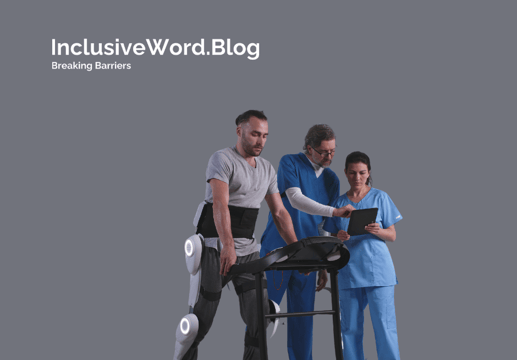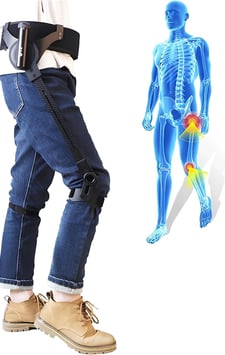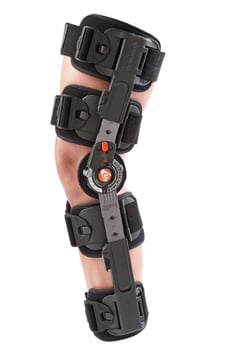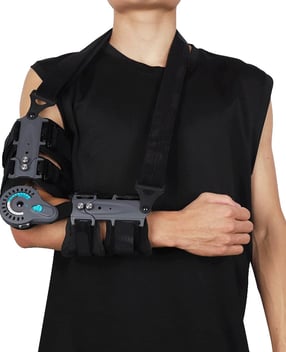Exoskeletons: The Future of Rehabilitation and Mobility
Exoskeletons, advanced robotic mobility aids, are revolutionizing rehabilitation, offering individuals with disabilities greater independence and improved quality of life. These wearable devices combine sensors, motors, and artificial intelligence to support movement, making strides in adaptive technology and inclusive design. This article explores how exoskeletons are transforming rehabilitation, their applications, challenges, and future potential.
NEWS
12/1/20245 min read


Exoskeletons, or exosuits, are wearable devices equipped with sensors, motors, and actuators that assist users with movement, strength, and endurance. In rehabilitation, these devices are invaluable for individuals recovering from spinal cord injuries, strokes, or neurodegenerative diseases. They support walking, standing, and other daily activities, enabling faster recovery and better outcomes.
For example, devices like ReWalk Robotics' exoskeleton empower individuals with spinal cord injuries to stand, walk, and climb stairs, significantly improving their independence. Similarly, Ekso Bionics’ EksoGT and EksoNR exoskeletons are tailored for stroke patients and those with lower-limb paralysis, providing targeted assistance to rebuild motor control and coordination.
Breakthrough Exoskeleton Technologies
Recent advances in exoskeleton technology highlight the innovative ways these devices are transforming rehabilitation. Here are some state-of-the-art examples:
Using deep learning algorithms, Georgia Tech’s exoskeleton controller enables dynamic movements such as jumping and lunging without recalibration. This innovation demonstrates the power of artificial intelligence in creating versatile, everyday mobility aids.
The Korea Advanced Institute of Science and Technology (KAIST) developed the WalkON Suit F1, which autonomously assists users in standing and walking. Its balance-enhancing features eliminate the need for additional support, showcasing user-friendly, inclusive design.
This AI-powered exoskeleton adapts to users’ strides, seamlessly handling activities like walking, running, and stair climbing. Trained in virtual environments, its adaptability ensures effectiveness in real-world settings.
Stanford researchers have designed a lightweight exoskeleton that improves walking speed and reduces energy expenditure. By utilizing machine learning, this device adjusts to users’ gaits, enhancing comfort and functionality.
Utah University Powered Exoskeleton for Amputees
Designed for lower-limb amputees, this powered exoskeleton reduces walking effort using motors and advanced algorithms. It mirrors the assistance provided by e-bikes, offering significant mobility improvements.
These examples illustrate how adaptive technology is reshaping mobility aids, making them smarter, more efficient, and tailored to individual needs.
Medical Applications: Enhancing Quality of Life
Exoskeletons have a profound impact on physical therapy and rehabilitation. Their medical applications include:
Spinal Cord Injuries: Enabling users to walk again, exoskeletons like ReWalk have transformed the lives of those with paraplegia.
Stroke Recovery: Devices such as Ekso Bionics’ exoskeletons aid stroke patients by rebuilding motor control and strength.
Neurological Conditions: For conditions like multiple sclerosis or Parkinson’s disease, exoskeletons provide support, helping users perform daily tasks.
Geriatric Care: Exoskeletons are increasingly used to assist older adults, reducing fall risks and enhancing mobility.
Beyond improving mobility, these devices boost confidence and foster greater independence, leading to better overall quality of life.
Overcoming Challenges in Exoskeleton Development
Despite their transformative potential, exoskeletons face several hurdles, including:
Cost Barriers
Exoskeletons are expensive, with prices often ranging from $30,000 to $100,000 or more, limiting accessibility.
Solutions: Manufacturers and researchers are exploring cost-effective materials like 3D-printed components and lightweight polymers to lower production expenses. Financial assistance programs and insurance coverage are also becoming more widely available.
Technological Limitations
Issues such as short battery life and the weight of devices hinder widespread use.
Solutions: Advances in energy-efficient batteries and shape memory alloys are improving operational time and reducing device weight.
Regulatory Challenges
The lack of standardized testing and regulatory frameworks slows the adoption of exoskeletons.
Solutions: Collaborative efforts among governments, healthcare providers, and manufacturers are addressing these gaps, ensuring devices meet safety and efficacy standards.
Inclusive Design: Making Exoskeletons Accessible
Inclusive design is central to developing effective and user-friendly exoskeletons. By prioritizing diversity and accessibility, manufacturers can create devices that benefit a wider range of individuals.
Key Principles of Inclusive Design
User-Centered Development: Engaging individuals with disabilities in the design process ensures that devices address their specific needs. For example, ReWalk Robotics involved users, therapists, and medical professionals during development.
Adjustability and Customization: Features like adjustable settings and modular components enable exoskeletons to cater to different body types and mobility levels.
Affordability and Accessibility: By focusing on cost reduction and equitable distribution, developers can ensure exoskeletons are accessible to underserved populations.
Inclusive design not only improves usability but also fosters social inclusion, making exoskeletons a vital tool for bridging mobility gaps.
The Future of Exoskeletons. The future of mobility aids is bright, with ongoing research driving the next wave of innovation. Here’s what to expect:
Advanced Materials. Lightweight and durable materials like carbon fiber and advanced polymers are making exoskeletons more comfortable and practical for everyday use.
Artificial Intelligence. AI will play a pivotal role in enhancing exoskeleton adaptability, allowing devices to learn and respond to users’ unique movements in real-time.
Affordable Options. As production costs decrease, exoskeletons are likely to become more affordable, broadening their accessibility to low-income individuals and communities.
Integration with Virtual Reality (VR). VR-based rehabilitation programs combined with exoskeletons can create immersive therapy experiences, accelerating recovery and improving outcomes.
Widespread Adoption in Everyday Life. Exoskeletons are gradually moving from clinical settings to home use, empowering individuals to integrate them seamlessly into their daily routines.
Popular Exoskeletons in Use Today
Several exoskeletons are leading the way in transforming rehabilitation:
ReWalk Robotics: Widely used for spinal cord injury recovery, offering mobility and independence.
Ekso Bionics: Focused on stroke recovery and lower-limb paralysis, providing personalized therapy support.
SuitX: Known for its lightweight design, this exoskeleton assists industrial workers and individuals with physical impairments.
Cyberdyne’s HAL: A Japanese exoskeleton aiding neurological and muscular recovery through bioelectrical signal-based movements.
Rex Bionics: This hands-free device is ideal for individuals with complete lower-limb paralysis, enabling upright mobility.
These devices showcase the diverse applications of exoskeleton technology and its potential to improve lives.
Exoskeletons represent a groundbreaking advancement in mobility aids and rehabilitation technology. By combining adaptive support, artificial intelligence, and inclusive design, these devices empower individuals with disabilities to achieve greater independence and improved quality of life.
As innovation continues, the accessibility and functionality of exoskeletons are set to expand, bridging gaps in mobility and fostering social inclusion. By embracing these advancements, we can move toward a future where mobility is no longer a barrier but a shared possibility for all.
The Bionic Body Power Walking Aid is an innovative mobility device designed for adults and the elderly. It mimics natural leg movements, aiding in walking and rehabilitation without requiring charging. Lightweight and portable, it's made from durable materials like aluminum and carbon fiber. This walking aid is easy to use, with adjustable straps for a comfortable fit, and suitable for those with unilateral paralysis or limb weakness. It enhances mobility, independence, and safety, making it a valuable tool for physical therapy and daily activities. However, it may be relatively expensive and requires some adjustment time for new users.
"Here are a few available examples"
The Brace Direct Breg T Scope Premier Post-Op Knee Brace provides exceptional support for knee recovery and injury management. Designed for both men and women, it features adjustable range-of-motion (ROM) control for precise movement limitation, ensuring optimal healing. The telescoping design and quick clip technology offer a customizable fit and easy application. Lightweight and padded for comfort, this brace is ideal for post-operative care and various knee injuries. Suitable for both left and right legs, it is available in size XL. This knee brace is a reliable solution for enhancing stability and comfort during rehabilitation.
The Hinged Elbow Brace provides excellent support for post-operative recovery and injury management. Designed for right arms, it features adjustable range-of-motion (ROM) control, allowing precise movement limitation to aid healing. The brace includes a sling stabilizer for added support and stability, and it’s padded for comfort. Its lightweight design and quick-release straps make it easy to apply and remove. Ideal for various elbow injuries and post-surgery care, this brace ensures proper healing and comfort throughout recovery. This versatile and user-friendly brace is a reliable choice for enhancing stability and supporting elbow rehabilitation.
InclusiveWorld.Blog
Breaking Barriers, Building Bridges
Contact us:
© 2024. All rights reserved.
Follow us






